
Assistive Technology Presentation
- 1. Assistive Technology Presentation ACQUANETTA PARROTT SEPTEMBER 10, 2015 ITEC 7530 -01F DR. EUNBAE LEE
- 2. Overview The modern educator is faced with many challenges today when it comes to educating the students that we come in contact with. This presentation is to focus on the students who need help with special needs in the classroom. In higher education, it is referred to as accommodations. I plan to give you outlets to use that will help you provide excellent education for those students with special needs in your classrooms and in your colleges.
- 3. Assistive Technology Definition: According to the University of Washington, assistive technology is technology used by individuals with disabilities in order to perform functions that might otherwise be difficult or impossible. Assistive technology can include mobility devices such as walkers and wheelchairs, as well as hardware, software, and peripherals that assist people with disabilities in accessing computers or other information technologies. Source: The National Center on Accessible Information Technology in Education, 2013. www.washington.edu/accessit/articles?109
- 4. The Need for Assistive Technology In K-12 Education To understand the implementation of Individualized Education Programs (IEP’s) To align your teaching styles and plans to the curriculum from the Tech Act and IDEA Act. To efficiently be effective in educating all students with disabilities through technology in a society focused on change. In Higher Education To effectively reach the estimated 11% of undergraduate and 7% of graduate students who report having a disability. To allow for students who have “hidden” or cognitive disabilities to feel comfortable. To be in accordance with the Individuals with Disabilities Act of 2004.
- 5. Meeting the Specific Needs There are many needs that need to be met when it comes to educating students with disabilities. Therefore, it is imperative to do research on technologies that will help you educate the holistic need of a student with a certain disability. The next few slides will demonstrate the assistive technologies that are available for all students, regardless of educational grade and status. The objective for the educator is to be able to use each technology resource in the classroom and aid the student in the process of knowing how to use it as well.
- 6. The ADHD Student: Computer Software: The purpose of these are to develop the reading, writing and math functions of the student Brain Training: Printouts, Brain Games: Hand held, On-line computer games Voice Recognition Software Talking Computer Keyboards E Dictionary Children’s Talking Calculator Screen Magnifiers To the right are several beneficial tools to help students learn who suffer from ADHD.
- 7. Auditory Disabled Student Learner: Children with auditory processing disorder often have trouble when there is a great deal of noise in the background, so teachers should work to create an environment with as few auditory distractions as possible. Children with auditory processing disorder should be seated somewhere near where instruction is being delivered. Verbal directions should be simplified and clarified as needed and many students respond well to written instructions and other visual cues in conjunction with verbal directions. Asking a student to repeat or paraphrase the directions after they have been delivered is another way to ensure that the student has heard properly.
- 8. Mild Disability Learners: The teacher can become creative for the mild disability learner. Note-Taking: A simple, no-tech approach to note taking is for the teacher to provide copies of structured outlines in which students fill in information. Writing: Word processing maybe the most important application of assistive learning for students with mild disabilities.
- 9. Summary Define your challenges Understand that each student with disabilities must be met and taught differently. Set realistic expectation See which assistive technology program works best with each student and measure their outcomes Keep your eye on the goal Share your findings with administrators, faculty and others who can benefit from your learning.
- 10. References ADHD Brain. (2012). Assistive Technology for ADHD. Retrieved from www.adhd-brain.com/assistive-technology-for-adhd.html Asselin, Susan B. Assistive Technology in Higher Education. Technology Integration in Higher Education. Retrieved from www.igi-global.com/chapter/assistive-technology-higher-education/51458 Behrmann, Michael and Jerome, Marci Kinas. (2002). Assistive Technology for Students with Mild Disabilities. Retrieved from www.ericdigests.org/2003-1/assistive.htm Strategies for Teaching Students with Auditory Processing Disorder. (2010). Retrieved from http://voices.yahoo.com/strategies-teaching-students-auditory- processing-6822736.html?cat=4 The National Center on Accessible Information Technology in Education. (2013). What is assistive technology? University of Washington. Retrieved from http://www.washington.edu/accessit/articles?109